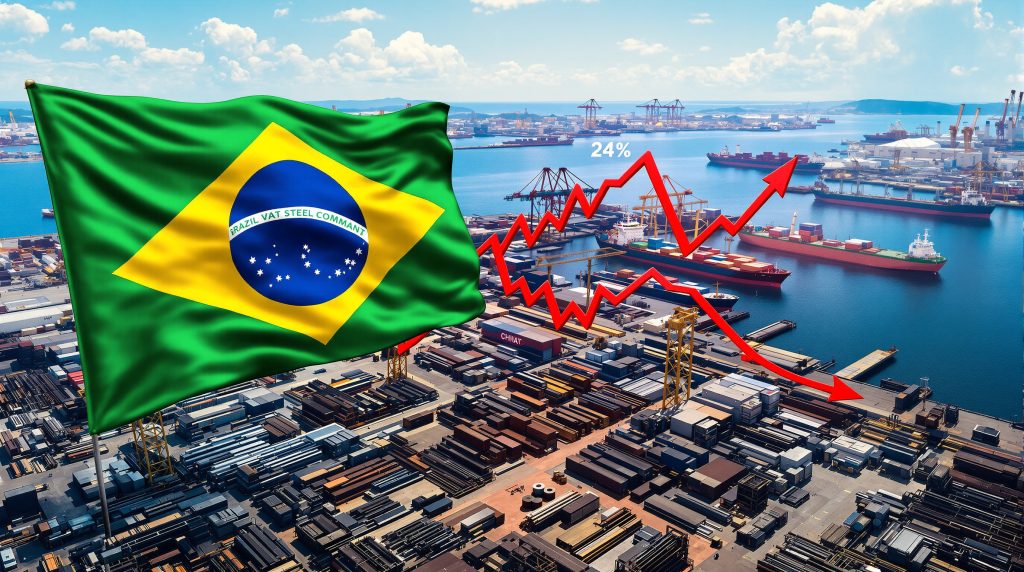Understanding Brazil's Steel Import Landscape: Trends, Challenges, and Future Outlook
How Has Brazil's Steel Import Market Evolved in Recent Years?
Current Import Trends and Volume Analysis
Brazilian steel imports have experienced a significant downturn, with recent data from Instituto Aço Brasil revealing a 24% year-on-year decline in August 2025. This substantial reduction reflects broader challenges affecting the entire steel sector within Brazil's economy. Simultaneously, domestic raw steel production decreased by 4.6% during the same comparative period, indicating systemic issues rather than simple import substitution.
The decline in steel imports into Brazil follows a consistent pattern established throughout 2025, with market analysts projecting this downward trajectory to continue well into the fourth quarter and possibly beyond. Trade data confirms import volumes have been shrinking steadily, with further declines expected from October onward.
Regional disparities remain a significant factor in Brazil's steel import dynamics. The country's northern and northeastern regions traditionally rely more heavily on imported steel due to their geographical distance from Brazil's main steel-producing facilities, which are predominantly concentrated in the southeast. This regional dependency creates varying impacts across different parts of the country as import volumes fluctuate.
Key Factors Driving Import Patterns
The primary driver behind declining steel imports into Brazil is the country's challenging macroeconomic environment. Brazil's benchmark interest rate (Selic) currently stands at 15%, representing the highest level in nearly two decades. This extreme financial environment has effectively paralyzed investment across multiple sectors, particularly in steel-intensive industries such as construction and manufacturing.
Industry sources confirm that weak internal demand across multiple sectors is affecting both imports and local production simultaneously. Construction projects face postponement or cancellation, manufacturing output has decreased, and overall steel consumption has contracted significantly across all major applications.
The uncertain economic outlook has prompted major Brazilian companies to revise their growth projections downward, with market consensus pointing toward continued challenging conditions. This corporate pessimism further suppresses steel demand as capital expenditure plans are delayed or scaled back.
Brazil's trade relationship with China, historically its largest steel import source, has entered a period of significant transition. Regulatory changes in China are reshaping export patterns and pricing structures, directly impacting Brazilian import volumes and sourcing strategies.
What Global Factors Are Reshaping Brazil's Steel Import Market?
China's Changing Export Landscape
A critical development affecting Brazil's steel import market is China's new enforcement of Value-Added Tax (VAT) requirements beginning October 1, 2025. This regulatory change represents a fundamental shift in the economics of Chinese steel exports to Brazil and other markets worldwide.
Previously, some Chinese suppliers employed tax avoidance strategies that enabled them to offer exceptionally competitive pricing in international markets, including Brazil. According to trade sources, this practice allowed certain exporters to undercut prices unfairly, creating market distortions while maintaining profitability.
The compulsory VAT collection, which is applied as a consumption tax at each production stage, eliminates these tax avoidance strategies. The immediate consequence will likely be an increase in Chinese export prices to Brazil, potentially reducing their competitiveness in the Brazilian market. This price adjustment could further decrease already declining import volumes from China, Brazil's traditionally dominant steel supplier.
Market sources with direct connections to Chinese suppliers anticipate significant disruption following the October 1 implementation. During recent supplier meetings, Chinese representatives expressed serious concerns about maintaining market share under the new tax enforcement regime, suggesting challenging conditions ahead for both exporters and importers.
International Trade Policy Implications
The shifting dynamics in Chinese steel exports are creating ripple effects throughout global steel trade patterns, with direct implications for Brazil's import-export balance. As Chinese steel potentially becomes less price-competitive in the Brazilian market, opportunities may emerge for alternative suppliers from different regions.
Other major steel-exporting nations, including South Korea, Japan, and Turkey, are closely monitoring these developments and potentially positioning themselves to increase market share in Brazil. However, these alternative suppliers face their own production constraints and domestic demand considerations that may limit their ability to significantly expand exports to Brazil in the near term.
For Brazilian importers, this evolving situation necessitates reassessment of sourcing strategies and supplier relationships. Many are exploring diversification options while simultaneously evaluating the economics of increased reliance on domestic production, despite its own challenges.
The shift in China's export policies may also influence broader South American regional steel trade patterns. Neighboring countries facing similar economic challenges might adjust their import-export strategies, potentially creating new competitive dynamics or collaborative opportunities within the region.
What Economic Conditions Are Affecting Brazil's Steel Market?
Interest Rate Impacts on Steel Demand
Brazil's Central Bank has maintained the country's benchmark Selic rate at 15%, an extraordinarily high level that continues to fundamentally reshape market dynamics across all sectors. This interest rate environment, implemented to combat persistent above-target inflation, has created severe challenges for steel-consuming industries.
The construction sector, traditionally Brazil's largest steel consumer, has been particularly devastated by these high interest rates. Housing projects face prohibitive financing costs, infrastructure initiatives have stalled, and commercial development has contracted significantly. Construction industry representatives report project cancellations and indefinite postponements have become commonplace, directly reducing steel consumption.
The manufacturing sector, another major steel consumer, similarly struggles with the dual challenges of high capital costs and weakened consumer demand. Automotive production, appliance manufacturing, and industrial equipment production have all reported reduced output, further constraining steel consumption across the supply chain.
Industry sources report that distributors are witnessing mills implementing aggressive pricing strategies simply to maintain material movement in this low-demand environment. This pricing pressure indicates the severity of current market conditions and suggests further downward price adjustments may be necessary to stimulate even minimal market activity.
Domestic Production Challenges
Local steel mills face considerable operational challenges amid the weakening demand environment. Production facilities are operating well below capacity, creating cost inefficiencies that further pressure profitability. Several major Brazilian steelmakers have already implemented production curtailments to align output with reduced market demand.
The pressure on domestic pricing has intensified as producers compete for limited market share in the contracted demand environment. Mills must balance production economics, inventory management, and market positioning while maintaining sufficient operational capacity to respond quickly should conditions improve.
Industry representatives have identified a concerning pattern of production inefficiencies emerging as facilities operate at suboptimal levels. These inefficiencies potentially compromise competitiveness compared to international producers with more stable domestic markets.
Market analysts tracking the sector have noted widespread downward guidance revisions from Brazilian steelmakers for coming quarters. This consensus view reflects the industry's recognition that current challenges are likely to persist, requiring strategic adjustments rather than short-term tactical responses.
What Is the Outlook for Brazil's Steel Imports in 2025-2026?
Short-Term Projections and Challenges
Steel imports into Brazil are expected to continue their decline from October 2025 onward, with multiple factors contributing to this downward trajectory. The implementation of China's compulsory VAT collection will likely accelerate this trend by increasing import costs from Brazil's largest steel source.
Continued pressure on both import volumes and domestic production appears inevitable through year-end 2025, as fundamental macroeconomic conditions show little sign of significant improvement in the near term. High interest rates are expected to persist as inflation control remains the Central Bank's priority.
Market sources anticipate particularly challenging conditions extending into early 2026, with potential stability emerging only in the second quarter. The combination of weak domestic demand, pricing pressures, and international supply chain adjustments creates a complex environment for all market participants.
Price adjustments will likely intensify as suppliers compete for limited demand, potentially creating short-term opportunities for strategic buyers able to leverage market conditions. However, these same conditions create significant uncertainty for importers attempting to develop coherent medium-term procurement strategies.
Potential Recovery Factors in 2026
Despite the challenging near-term outlook, market sources identify potential catalysts for recovery beginning in 2026, coinciding with Brazil's election year. Historical patterns suggest increased public spending during election cycles, particularly targeting visible infrastructure and housing initiatives.
Government-backed stimulus programs typically focus on civil construction sector projects, especially low-income housing developments that generate significant steel demand. These programs historically provide temporary relief to steel markets during otherwise challenging periods, though their sustainability beyond election cycles remains questionable.
The construction sector, currently among the most severely impacted by high interest rates, would be the primary beneficiary of such election-year initiatives. Even modest improvement in construction activity could significantly impact steel demand given the sector's current depressed state.
While election-related spending may provide temporary stimulus, sustainable recovery ultimately depends on broader macroeconomic improvement, particularly regarding interest rates and investment climate. Market participants recognize that election-year effects typically create short-term demand boosts rather than fundamental market shifts.
How Are Brazilian Steel Market Participants Responding?
Industry Adaptation Strategies
Distributors across Brazil are implementing strategic inventory adjustments to align with reduced demand expectations. Many report significantly reduced stocking levels, focusing instead on high-turnover products while minimizing exposure to specialized items with uncertain demand.
Steel mills are implementing competitive pricing strategies to maintain market share despite challenging conditions. Industry sources report producers pushing prices down to keep material moving through the supply chain, with further price adjustments likely as competition for limited demand intensifies.
Import-focused businesses are actively reassessing their sourcing strategies in response to Chinese tax changes. Many are exploring alternative supplier relationships while simultaneously evaluating increased reliance on domestic production despite its own challenges.
The investment community has broadly revised sector outlooks and guidance downward for coming years. Financial analysts tracking the Brazilian steel sector note consensus expectations for continued challenging conditions, with recovery timelines extending further than previously anticipated.
Market Sentiment and Expert Perspectives
Industry consensus points toward continued difficult conditions through late 2025, with most market participants preparing for an extended period of demand weakness. Trade sources consistently highlight fiscal concerns as the primary driver of market challenges, with limited expectations for near-term improvement.
Distributor reports confirm downward price pressure throughout the domestic market, with expectations for further price deterioration in coming months. This pricing environment creates margin challenges throughout the supply chain while potentially stimulating limited demand through improved affordability.
Investment analysts tracking the sector note widespread downward revision of growth expectations across major Brazilian companies. This corporate pessimism suggests industry leaders anticipate persistent challenges rather than quick recovery.
Despite the predominantly negative sentiment, some market participants identify potential strategic opportunities emerging from the current environment. Consolidation possibilities, market share gains for financially strong players, and potential for advantageous asset acquisitions represent potential silver linings within the challenging market context.
The uncertain global economic landscape further complicates Brazil's steel market outlook. The combination of US–China trade tensions and fluctuating iron ore price trends creates additional complexity for market participants attempting to formulate coherent strategies. Moreover, the potential implementation of additional steel tariffs impact from major steel-producing countries could further disrupt global trade patterns and affect Brazil's import-export dynamics.
FAQ: Brazil's Steel Import Market
Why are Brazil's steel imports declining in 2025?
Brazil's steel imports are declining due to a combination of factors, most notably weak domestic demand driven by exceptionally high interest rates (15%), which have effectively paralyzed investment across steel-consuming sectors. Additionally, changes in Chinese export tax enforcement beginning October 2025 are making imports less price-competitive, while broader economic uncertainty has prompted Brazilian companies to scale back growth expectations and capital investments.
How will China's new VAT enforcement affect Brazilian steel imports?
China's compulsory VAT collection beginning October 1, 2025, eliminates previous tax avoidance strategies that had enabled some Chinese suppliers to offer exceptionally competitive pricing in the Brazilian market. This regulatory change will likely increase Chinese export prices, reducing their price advantage and potentially decreasing import volumes from what has traditionally been Brazil's largest steel import source. Market sources anticipate significant disruption following implementation, potentially accelerating the decline in steel imports into Brazil.
When might Brazil's steel market begin to recover?
Market sources suggest potential recovery could begin in 2026, coinciding with Brazil's election year. Historically, election periods bring government-backed stimulus programs targeting civil construction, especially low-income housing projects that drive steel demand. However, sustainable recovery depends on broader macroeconomic improvement, particularly regarding interest rates and investment climate. The relationship between the US economy and tariffs will also play a critical role in shaping global steel markets, potentially affecting Brazil's recovery timeline.
What sectors in Brazil are most affected by the steel market slowdown?
The civil construction sector has been most severely impacted, as high interest rates have made project financing prohibitively expensive, leading to widespread project cancellations and postponements. Manufacturing industries, including automotive production, appliance manufacturing, and industrial equipment production, have also reported reduced output. Infrastructure development has stalled, further constraining steel demand across the economy.
How are Brazilian steel producers responding to current market conditions?
Domestic steel producers are implementing multiple adaptation strategies, including production volume adjustments to align output with reduced demand, competitive pricing initiatives to maintain market share, and operational efficiency improvements to preserve profitability despite suboptimal production levels. Industry sources report mills pushing prices down to keep material moving through the supply chain, with further price adjustments likely as competition for limited demand intensifies. Global economic factors, including ongoing tariffs and global uncertainty, further complicate strategic planning for Brazilian producers.
Disclaimer: This article contains forward-looking statements and market projections based on current information and expert opinions. Economic conditions, regulatory changes, and market dynamics may evolve differently than anticipated. Readers should consult additional sources and professional advisors before making business or investment decisions based on this information.
Ready to Catch the Next Major Mining Discovery?
Explore how Discovery Alert's proprietary Discovery IQ model can deliver real-time notifications on significant ASX mineral discoveries, giving you the edge in identifying potentially transformative investment opportunities before the broader market. Begin your 30-day free trial today at Discovery Alert and position yourself to capitalise on the next major discovery announcement.




